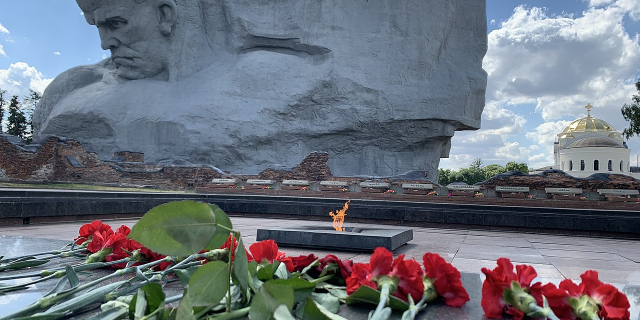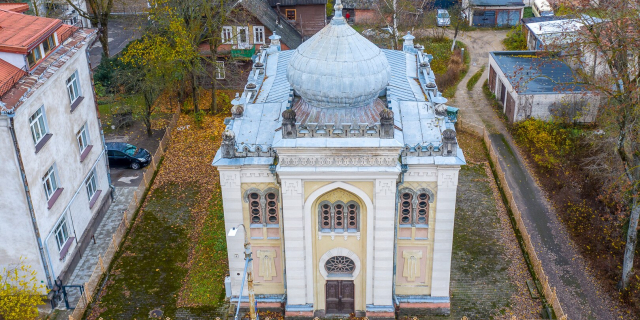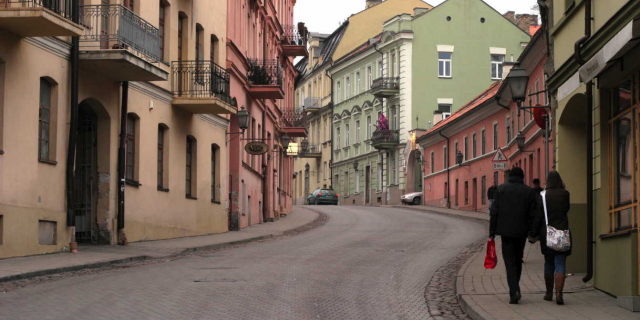Puszcza Białowieska
( Białowieża Forest )
Białowieża Forest is a forest on the border between Belarus and Poland. It is one of the last and largest remaining parts of the immense primeval forest that once stretched across the European Plain. The forest is home to 800 European bison, Europe's heaviest land animal. UNESCO's Man and the Biosphere Programme designated the Polish Biosphere Reserve Białowieża in 1976 and the Belarusian Biosphere Reserve Biełavieskaja pušča in 1993.
In 2015, the Belarusian Biosphere Reserve spanned 216,200 ha (2,162 km2; 835 sq mi), subdivided into transition, buffer and core zones. The forest has been designated a UNESCO World Heritage Site and an EU Natura 2000 Special Area of Conservation. The World Heritage Committee, through its decision of June 2014, approved the extension of the UNESCO World Heritage sit...Read more
Białowieża Forest is a forest on the border between Belarus and Poland. It is one of the last and largest remaining parts of the immense primeval forest that once stretched across the European Plain. The forest is home to 800 European bison, Europe's heaviest land animal. UNESCO's Man and the Biosphere Programme designated the Polish Biosphere Reserve Białowieża in 1976 and the Belarusian Biosphere Reserve Biełavieskaja pušča in 1993.
In 2015, the Belarusian Biosphere Reserve spanned 216,200 ha (2,162 km2; 835 sq mi), subdivided into transition, buffer and core zones. The forest has been designated a UNESCO World Heritage Site and an EU Natura 2000 Special Area of Conservation. The World Heritage Committee, through its decision of June 2014, approved the extension of the UNESCO World Heritage site "Belovezhskaya Pushcha/Białowieża Forest, Belarus, Poland", which became "Białowieża Forest, Belarus, Poland". It straddles the border between Poland (Podlaskie Voivodeship) and Belarus (Brest and Grodno Regions), and is 70 kilometres (43 miles) north of Brest, Belarus and 62 kilometres (39 miles) southeast of Białystok, Poland. The Białowieża Forest World Heritage site covers a total area of 141,885 ha (1,418.85 km2; 547.82 sq mi). Since the border between the two countries runs through the forest, there is a border crossing available for hikers and cyclists.
 Map of the forest's location between the rivers Naruva and Bugas
Map of the forest's location between the rivers Naruva and Bugas Belovezhskaya Pushcha coat of arms on Pre-Stamped Envelope of the Belarus, 2009: 600th Anniversary of Belovezhskaya Pushcha reserve status
Belovezhskaya Pushcha coat of arms on Pre-Stamped Envelope of the Belarus, 2009: 600th Anniversary of Belovezhskaya Pushcha reserve statusThe entire area of northeastern Europe was originally covered by ancient woodland similar to that of the Białowieża Forest. Until about the 14th century, travel through the woodland was limited to river routes; roads and bridges appeared much later. Limited hunting rights were granted throughout the forest in the 14th century. In the 15th century the forest became a property of Grand Duke Jogaila. A wooden manor in Białowieża became his refuge during a plague pandemic in 1426.[citation needed] The first recorded piece of legislation on the protection of the forest dates to 1538, when a document issued by Sigismund I instituted the death penalty for poaching a bison.[1] The King also built a new wooden hunting manor in a village of Białowieża, which became the namesake for the whole complex. Since Białowieża means the "white tower", the corresponding Puszcza Białowieska translates as the "forest of the white tower". The Tower of Kamyenyets on the Belarusian side, built of red brick, is also referred to as the White Tower (Belaya Vezha) even though it was never white, perhaps taking the name from the pushcha.[2]
The forest was declared a hunting reserve in 1541 to protect bison. In 1557, the forest charter was issued, under which a special board was established to examine forest usage. In 1639, King Vladislaus IV issued the "Białowieża royal forest decree" (Ordynacja Puszczy J.K. Mości leśnictwa Białowieskiego). The document freed all serfs living in the forest in exchange for their service as osocznicy, or royal foresters. They were also freed of taxes in exchange for taking care of the forest. The forest was divided into 12 triangular areas (straże) with a centre in Białowieża.
 Part of primaeval forest with dead 450-year-old oak in Białowieża National Park, Poland
Part of primaeval forest with dead 450-year-old oak in Białowieża National Park, PolandUntil the reign of King John II Casimir, the forest was mostly unpopulated. However, in the late 17th century, several small villages were established for development of local iron-ore deposits and tar production. The villages were populated with settlers from Masovia and Podlaskie and many of them still exist.
After the Partitions of Poland, Tsar Paul I turned all the foresters into serfs and handed them over to various Russian aristocrats and generals along with the parts of forest where they lived. Also, a large number of hunters were able to enter the forest, as all protection was abolished. Following this, the number of bison fell from more than 500 to fewer than 200 in 15 years. However, in 1801, Tsar Alexander I reintroduced the reserve and hired a small number of foresters to protect the animals, and by the 1830s there were 700 bison. However, most of the foresters (500 out of 502) took part in the November Uprising of 1830–31, and their posts were abolished, leading to a breakdown of protection.
Tsar Alexander II visited the forest in 1860 and decided to re-establish the protection of bison. Following his orders, locals killed all predators: wolves, bears and lynx. Between 1888 and 1917, the Russian tsars owned all of primaeval forest, which became the royal hunting reserve. The tsars sent bison as gifts to various European capitals, while at the same time populating the forest with deer, elk and other animals imported from around the empire.
The last Russian royalty visit was by Czar Nicholas II in 1912.[3]
20th-century wartime damage and restoration Bison in Białowieża Forest
Bison in Białowieża Forest Royal Oaks Trail, Białowieża Forest
Royal Oaks Trail, Białowieża Forest Stephanopachys linearis specimen collected in Białowieża Forest in 2015.
Stephanopachys linearis specimen collected in Białowieża Forest in 2015.During World War I the forest suffered heavy losses. The German army seized the area in August 1915 and started to hunt the animals. During three years of German occupation, 200 kilometres (124 miles) of railway tracks were laid in the forest to support the local industry. Three lumber mills were built, in Hajnówka, Białowieża and Gródek. Up to 25 September 1915, at least 200 bison were killed, and an order was issued forbidding hunting in the reserve. However, German soldiers, poachers and Soviet marauders continued the slaughter until February 1919 when the area was captured by the Polish army. The last bison had been killed just a month earlier. Thousands of deer and wild boar had also been shot.
After the Polish–Soviet War in 1921, the core of the forest was declared a National Reserve. In 1923, Professor Józef Paczoski, a pioneer of the science of phytosociology, became a scientific manager of the forest reserves in the Białowieża Forest. He carried out detailed studies of the structure of forest vegetation there.[4][5][6]
In 1923 it was known that only 54 European bison survived in zoos all around the world, none of them in Poland. In 1929, a small herd of four was bought by the Polish state from various zoos and from the Western Caucasus (where the bison was to become extinct just a few years later). These animals were of the slightly different Caucasian subspecies (Bison bonasus caucasicus). To protect them, in 1932 most of the forest was declared a national park. The reintroduction proved successful, and by 1939 there were 16 bison in Białowieża National Park. Two of them, from the zoo in Pszczyna, were descendants of a pair from the forest given to the Duke of Pszczyna by Tsar Alexander II in 1865.
In 1939 the local inhabitants of Polish ethnicity were deported to remote areas of the Soviet Union and replaced by Soviet forest workers. In 1941 the forest was occupied by Germans and the Russian Soviet inhabitants were also expelled. Hermann Göring planned to create the largest hunting reserve in the world there. After July 1941 the forest became a refuge for both Polish and Soviet partisans and Nazi authorities organised mass executions. A few graves of people who were killed by the Gestapo can still be seen in the forest. (Hermann Göring directed anti-partisan operations by Luftwaffe security battalions in the Białowieża Forest between 1942 and 1944 that resulted in the murder of thousands of Jews and Polish civilians.)[7] In July 1944 the area was overtaken by the Red Army. Withdrawing Wehrmacht troops demolished the historic Białowieża hunting manor.
After the war, the forest's territory was divided between Poland and the Belarusian SSR of the Soviet Union. The chairman of the Polish Committee of National Liberation, Edward Ochab, wrote in his memoirs regarding the negotiations about the demarcation of the border in the area of Białowieża Forest. According to his view, the Soviet officials repeated many times that they were not interested in enlarging their vast state, but only in sorting out the issue of Belarusian and Ukrainian nationalities in the borderland area (Kresy). Ochab emphasized to his Soviet negotiators that the problem didn't exist in Białowieża Forest and that the forest had a special historical place in the Polish national memory as a place where guerilla fights took place during the uprising against the tsarist regime. In addition, Poland had its forests decimated by the Germans during the occupation of Poland and finally, the forest was Poland's raw material basin for the timber industry in Hajnówka. According to Ochab's memories, when Stalin fiercely insisted on the need to "close the case", Ochab requested a break for consultations in the nearby room. He told his associates from the PKWN that he would resign from his position as the chairman of that body, as he could not find enough spiritual strength and inner conviction to promote Polish–Soviet friendship. The conversation was interrupted and the delegation was escorted to the premises in the seat Union of Polish Patriots and waited for news from the Soviet government. After a half an hour or so, Soviet Foreign Minister Vyacheslav Molotov called and informed Ochab by phone that Stalin had agreed to transfer half of the forest to Poland including the village of Białowieża and congratulated him. According to Ochab, he was unhappy with the decision as he was counting on the entire Białowieża Forest.[8]
The Soviet part was put under public administration while Poland reopened the Białowieża National Park in 1947. Belovezhskaya Pushcha was protected under Decision No. 657 of the Council of People's Commissars of the Soviet Union, 9 October 1944; Order No. 2252-P of the USSR Council of Ministers, 9 August 1957; and Decree No. 352 of the Byelorussian SSR Council of Ministers, 16 September 1991.
In December 1991, the Belavezha Accords, the decision to dissolve the Soviet Union, were signed at a meeting in the Belarusian part of the reserve by the leaders of Ukraine, Russia and Belarus.


































Add new comment